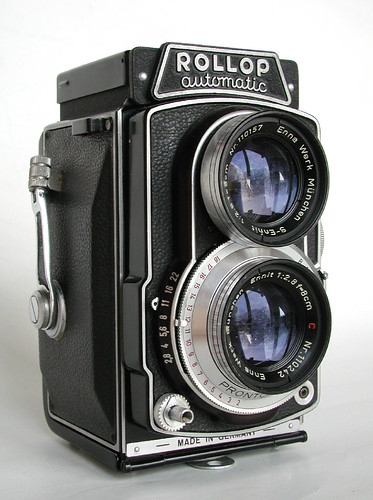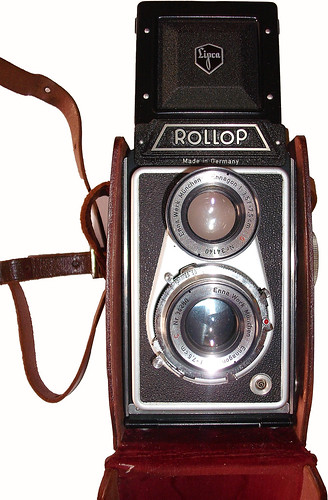Difference between revisions of "Rollop"
Hanskerensky (talk | contribs) (A bit more information and Bibliography) |
Hanskerensky (talk | contribs) (→Rollop II: Rollop II, more specs) |
||
| Line 54: | Line 54: | ||
|image_rights= with permission | |image_rights= with permission | ||
}} | }} | ||
| − | Very similar to the Rollop I but now has a crank for filmtransport. | + | Very similar to the Rollop I but now has a crank for filmtransport and a counter. |
* Production period : 1954 | * Production period : 1954 | ||
* Format : 12 exposures of 6 x 6 cm on [[120]] type rollfilm. | * Format : 12 exposures of 6 x 6 cm on [[120]] type rollfilm. | ||
| Line 61: | Line 61: | ||
* Filter Size : ?? | * Filter Size : ?? | ||
* [[Parallax]] error correction : ?? | * [[Parallax]] error correction : ?? | ||
| − | * Shutter: [[Prontor- | + | * Shutter: [[Prontor-S]] (rare) or [[Prontor-SVS]] leafshutter. Speeds 1 to 1/300 sec. and B. |
* Flash synchronisation : Sync socket on frontpanel. M and X synchronisation. | * Flash synchronisation : Sync socket on frontpanel. M and X synchronisation. | ||
* Selftimer | * Selftimer | ||
| − | * Filmtransport : Crank winder. Automatic stop.<br/> | + | * Filmtransport : Crank winder. Automatic stop. Counter<br/> |
* Double exposure prevention | * Double exposure prevention | ||
* Accessory shoe : On left side (only on later cameras). | * Accessory shoe : On left side (only on later cameras). | ||
Revision as of 18:06, 30 March 2015
| |||
| German TLR () | |||
|---|---|---|---|
| 35 mm | Contaflex | Flexilette | Optima Reflex | ||
| 3×4 | Pilot Reflex | ||
| 4×4 | Baby Rolleiflex (1931) | Baby Rolleiflex (1957) | Karma-Flex | ||
| 6×6 | Altiflex | Amplion Reflex | Brillant | Flektar | Flexo | Flexora | Flexora II | Flexora III | Foth-Flex | Ikoflex 1 | Ikoflex II | Ikoflex Ia | Ikoflex Ic Ikoflex Favorit | Karma-Flex | Mentorett | Montiflex | Peerflekta | Perfekta | Photina Reflex | Plascaflex | Reflecta | Reflekta | Reflekta II | Rica Flex | Rocca Automatic | Rocca Super Reflex | Rolleiflex | Rolleicord | Rollop | Superb | Superflex | Trumpfreflex | Vitaflex | Weltaflex | Wirgin Reflex | Zeca-Flex | ||
| 6×9 | Superfekta | ||
This is not the Roll-Op by Plaubel.
Rollop is the name of a series of TLR models made by the German company Lipca introduced in 1954. Were the former Lipca TLR's, the Flexo and Flexora, still made of sheet metal now there is a change to a body made of injection molded aluminium. The name Rollop is not accidentally close to Plaubel's Roll-Op. There were close connections between Lipca and Plaubel. Plaubel even gave the rights on the Roll-Op trade name to Lipca.
Rollop I
The first in the Rollop series.
- Production period : 1954
- Format : 12 exposures of 6 x 6 cm on 120 type rollfilm.
- Taking lens:Enna Ennagon 1:3.5 f=7.5cm (75mm on later cameras), Coated.
- Viewing lens: Enna Sucher (=viewfinder) or Ennagon 1:3.5 f=7.5cm (75mm on later cameras).
- Filter Size : ??
- Parallax error correction : ??
- Shutter: Prontor-S, Prontor-SV or Prontor-SVS leafshutter. Speeds 1 to 1/300 sec. and B.
- Flash synchronisation : Sync socket on frontpanel. M and X synchronisation.
- Selftimer
- Filmtransport : Knob winder. Red window on the back to display film frame number.
- Double exposure prevention
- Accessory shoe : On left side (only on later cameras).
- Dimensions WxHxD: ?? x ?? x ?? mm
- Weight: ??? grams

|
| Lipca Rollop I (late model) image by Hubertus Bendi (Image rights) |

|
| back view of Lipca Rollop I (early model) image by John-Henry Collinson (Image rights) |
Rollop II

|
| Lipca Rollop II image by OZBOX (Image rights) |
Very similar to the Rollop I but now has a crank for filmtransport and a counter.
- Production period : 1954
- Format : 12 exposures of 6 x 6 cm on 120 type rollfilm.
- Taking lens:Enna Ennagon 1:3.5 f=7.5cm, Coated.
- Viewing lens: Enna Ennagon 1:3.5 f=7.5cm. Coated.
- Filter Size : ??
- Parallax error correction : ??
- Shutter: Prontor-S (rare) or Prontor-SVS leafshutter. Speeds 1 to 1/300 sec. and B.
- Flash synchronisation : Sync socket on frontpanel. M and X synchronisation.
- Selftimer
- Filmtransport : Crank winder. Automatic stop. Counter
- Double exposure prevention
- Accessory shoe : On left side (only on later cameras).
- Dimensions WxHxD: ?? x ?? x ?? mm
- Weight: ??? grams
Rollop Automatic

|
| Lipca Rollop Automatic image by Hubertus Bendi (Image rights) |
The top model in the Rollop series. Called Automatic because the filmtransport crank now also cocks the shutter
Early Automatics are just named "Rollop" on the name shield and have Enna Lithagon lenses.
The camera has a Prontor SVS shutter with speeds of 1–1/300s and B. Both lenses are Ennit 80mm f/2.8 of a four-element Tessar type, made by Enna in Munich. The camera has knob focusing and lever wind with automatic shutter cocking as on a Rolleiflex. The waist-level finder has a fresnel screen with split rangefinder and grid lines for easier composition. The camera has an EVS (light value) system, locking shutter speed and aperture, like that on the Flexaret VII. This can be switched off.
- Production period : 1956
- Format : 12 exposures of 6 x 6 cm on 120 type rollfilm.
- Taking lens: Enna S-Lithagon 1:2.8 f=80mm or S-Ennit 1:2.8 f=8cm. Coated.
- Viewing lens: Enna Lithagon 1:2.8 f=80mm or Ennit 1:2.8 f=8cm. Coated.
- Filter Size : ??
- Parallax error correction : ??
- Shutter: Prontor-SVS leafshutter. Speeds 1 to 1/300 sec. and B. With light-value system
- Flash synchronisation : Sync socket on frontpanel. M and X synchronisation.
- Selftimer
- Filmtransport : Crank winder. Automatic stop and shutter cocking.
- Double exposure prevention
- Accessory shoe : On left side.
- Dimensions WxHxD: ?? x ?? x ?? mm
- Weight: ??? grams
Bibliography
- Personal Lipca research documentation, courtesy of long time Lipca collector and history investigator Herr Ulf Schopfer, Bad Pyrmont, Germany
- Peter Barz, article "Lipca Teil 1, eine Neugründung der Nachkriegszeit" in the German magazine "Photographica Cabinett 25/02"
- Peter Barz, article "Lipca Teil 2, Die Kameras der Lippischen Camerafabrik Richter & Fischer GmbH, Barntrup" in the German magazine "Photographica Cabinett 26/02"
- Peter Barz, article "Lipca Teil 3, Lipca, Lippische Camerafabrik Richter & Fischer GmbH, Barntrup" in the German magazine "Photographica Cabinett 27/02"
Links
In English:
- A Rollop description on medfmt.8k.com.
- Rollop / Lipca section at Retrography.com by Simon Simonsen, Denmark
In German:
- A Rollop camera ad at the 1956 Photokina
In French:
- Rollop Automatic on www.collection-appareils.fr by Sylvain Halgand
